
Cibola NWR Near Blythe, California
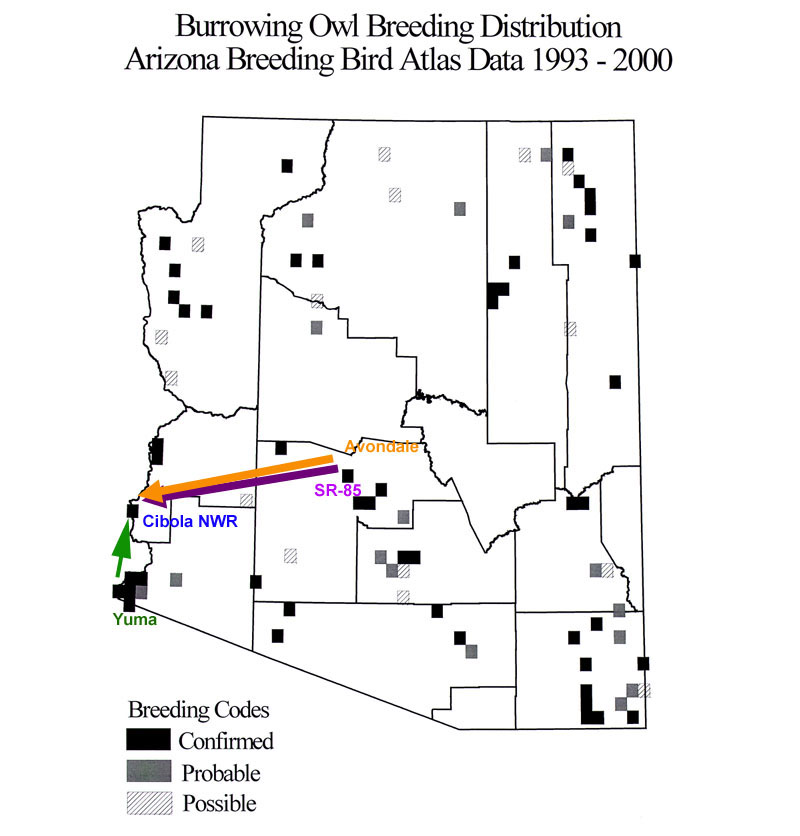

In 2010 Wild At Heart relocated Burrowing Owls to Cibola National Wildlife Refuge. The map on this page shows where some of the owls originated. Before relocation all of the Burrowing Owls are held for at least 60 days (usually longer) at the care facility in Cave Creek, AZ near Phoenix. Volunteers installed about 120 artificial burrows at the refuge and some of these are used to hold the owls inside tents for 30 days to let the owls build site fidelity to their new home. Cibola NWR provided a backhoe and operator for creating the trenches where the burrows are installed.
Here is more information about this Wild At Heart funded project. Photos by Greg Clark
 |
Here US Fish and Wildlife Service volunteers and staff attach the 4-inch flexible black tubing to four of the eight burrow chambers that make up the release burrows. One volunteer is hammering in a steel rebar to anchor the rigid 6-inch white PVC tubing that hardens the burrow entrance to prevent the soft black tubing from being chewed or dug up by dogs. |
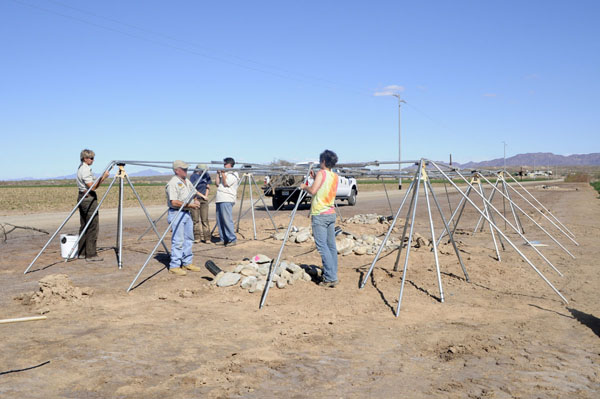 |
The release tent canopy is held up by pre-fabricated steel sections that are assembled on-site. The tubing is bolted together and the tubing intersections are secured by steel wire. The main corner and center four-leg supports are secured to the soil by rebar and wire. The Eight burrows inside the tent are capped while work on the frame is underway. Rocks are piled on the soil over the burrow tubing near the entrance to discourage dogs from trying to dig up the tubing. |
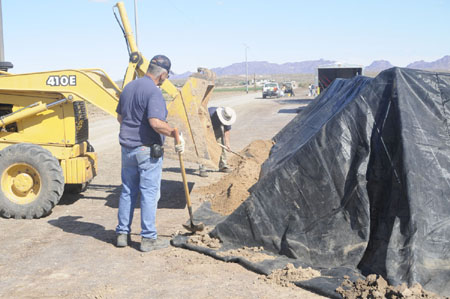 |
To resist high winds the shade fabric (that blocks light, but lets a breeze blow through) must be anchored by enough soil. Here volunteers supervise the transfer of soil from thebackhoe bucket to the tent apron to be sure the bucket doesn't hit the tent. |
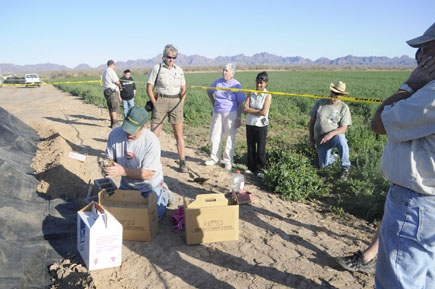 |
Here Bob Fox with Wild At Heart removes one of the relocated owls from a cardboard carrier. At the care facility small groups of male and female owls have been kept together so that they can form a colony. This colony is kept intact when the owls are transferred into the release tent. Typically, each release tent populated by owls in the Spring will have at least one, and usually more, breeding pairs that lay eggs while still in the tent. Volunteers at Cibola NWR delivered thawed frozen mice and clean water to the owls in all four release tents every day. |
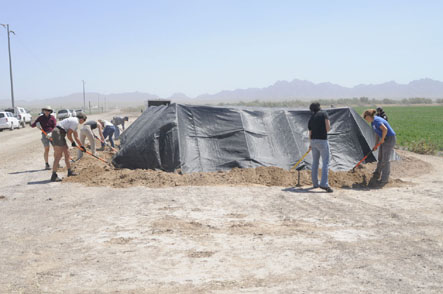 |
After 30 days it is time to remove the tent fabric. At sites with multiple tents the removal is staggered so not all owls are released at the same time. Here volunteers remove the soil by hand to protect the fabric. Before the fabric is removed the expansion burrows, installed all over the Refuge facility, are opened so owls that immediately want to find a new burrow will find a large selection nearby. Some owls are not breeding in the tent, but do set up at expansion burrows after they leave the release burrows under the tent. |
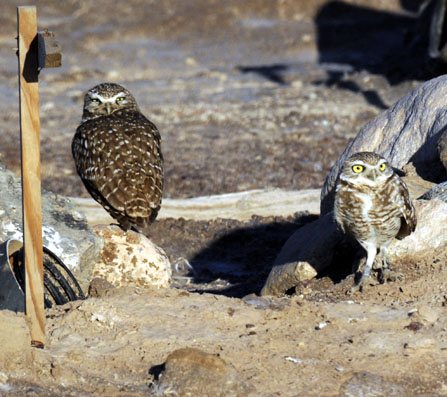 |
The owls were relocated in 2010. In March of 2011 the first Wild At Heart monitoring was done to determine if females had migrated back. Typically, the males stay with the burrows year-round and the females migrate from September to March. Here, one female is shown near her probable mate. Black colored bands usually designate female owls and green bands designate male owls. This black band is 89W and was placed on an adult female. This owl was originally located near I-10 and El Mirage Road at a Maricopa County Flood Control project near friendship park. The map at the top of this page shows where this owl was located by the place name "Avondale". This owl was relocated approximately 150 miles, straight line distance, from central Arizona to Cibola NWR. |
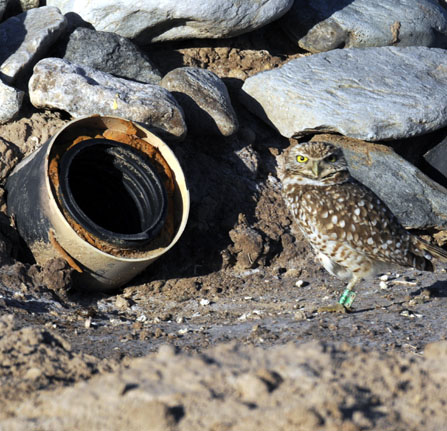 |
Here one of the male relocated owls dutifully guards the burrow entrance, perhaps watching out for his mate sitting on eggs down in the burrow. The green band is number 84C revealing that this owl was originally located near the East Main Canal in Yuma, AZ. The silver band is the typical US Fish and Wildlife Service band. Both bands are placed on the owls just before they leave Cave Creek and transported to the release site. |
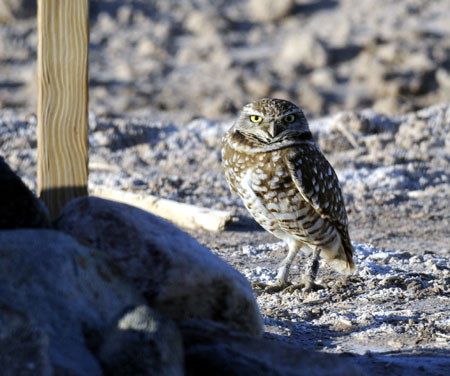 |
Another female owl with a black band stands near the base of a wood perch near the burrow entrance. This owls wears band number 76V and this means this owl was originally located near SR85 and Broadway Road in central AZ. This is shown as "SR-85" on the map at the top of the page. This owl was also relocated about 150 miles to Cibola NWR. |
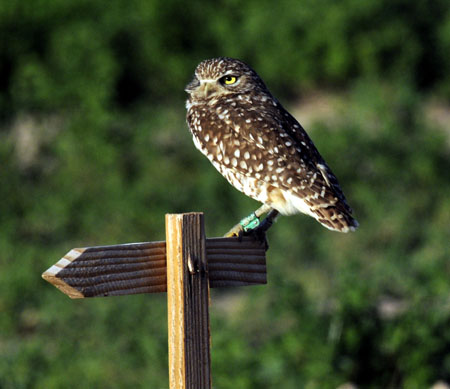 |
This handsome male owl is also shown up at the top of this page. The band number 86C shows that this is another owl originally located near Yuma. Male owls in central and southern Arizona typically stay with the burrow after the female migrates (often Mexico) in September. When the female returns around March the male has protected his territory and is ready to support a new family. Unlike other owls, male Burrowing Owls are larger than females. This is probably because the female is often confined to the small burrow nesting chamber while the male is responsible for bringing food to the incubating female and to the many baby owls after hatching. Both relocated owls and local owls can be found using the new artificial burrows at Cibola NWR. |
Questions?, type in b i r d i n f o @ m i r r o r - p o l
e . com into your email program to contact us.











